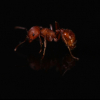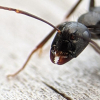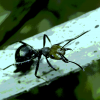So, today i lifted one of the many bricks that's above a Lasius flavus colony around my house. Found this girl running from one of the brood piles. I scooped her, and the brood pile she was running from.
Now here's were it's tricky to me. If she's the original queen from that colony, i want to put her back. It's a big beautiful colony that's producing many many alates. Now, the other idea was that she may be parasitic. Although, her body shape doesn't look parasitic. And comparing her to my L.unbratus, she's bigger with a more rounded off, swollen gaster. If she is parasitic, was she about to pull off her heist? Kind of at a loss of what to do.
Location: Mid-Michigan. USA
Under a brick, next to house.
5~6mm long.
Near Lasius flavus colony.
Here is her next to my L.unbratus. New queen is in the box

And here is just her.























